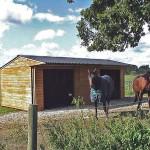Itâs at this time of the year, when the ground is solid and the air is warm and dry, that it is the best time to carry out any maintenance that you may need to undertake on your timber outbuildings.
I would always advocate that you check the condition of your stables and outbuildings at least once a year. This way you can identify anything that may need attention immediately and you will be able to prevent any further problems in the winter.
Most timber building deterioration is caused by water and sunlight. If unprotected and left damp, wood can decay and this could eventually destroy the structure. The impact of wind-blown debris can also damage buildings or create a problem area where water penetration may begin its destructive impact.
What To Do
Firstly, walk around the outside of your buildings. Look out for any evidence of leaks and dampness. Make a note of any areas of storm damage and areas of staining on the wood where rain water may have come in.
When looking inside your buildings use a torch to inspect dark areas and look out for spoiled hay or debris that may be covering damaged wood. Make a list of possible problem areas.
Replace any damaged kickboards with ideally a good quality plywood. Do not use a board known as âOSB Strand boardâ as it has very little impact strength and could cause your horses potentially serious harm if they kick a hole in this boarding and catch their hooves in the hole created.
Structural grade Plywood has much more strength and will not puncture in the same way as inferior boards. Always use plywood kickboards for their strength and durability.
Check your guttering for any blockages. It is amazing how often what appears to be a faulty gutter is simply a build up of fallen leaves stopping the gutter from flowing effectively.
At this time of the year, after winter has passed it is advisable to check the roof for any wind damage. Corrugated roof sheets are wind tested to at least 120mph, but it pays to make sure that the fixing nails have not worked loose. If they have, just tap them down again with a hammer.
Felt roofing typically lasts between ten and twenty-five years. Although once asphalt begins to leak the whole roof generally must be replaced. Sunlight on the south side or moisture on the north side of roofs may lead to one side wearing out before the other.
It is a good idea to have a builder go around and carry out the inspection with you to estimate any repairs and assess the condition of your stables and outbuildings.
Make a Plan
Once you have assessed the condition of your buildings, it is wise to develop a maintenance plan and decide your repair priorities, then set a timescale for doing the work and stick to it.
Some of the work you may be able to do yourself, but other work could be done more quickly and effectively by a professional builder.
External Re-treatment
Every three years or so, it is advisable to recoat the outside of your buildings with a good quality treatment. I have found Cuprinol to be an excellent animal friendly product that is easy to apply with a brush and comes in many colours.
Tanalised timber tends to bleach out and go grey after a period of time. A couple of coats of Cuprinol should bring this wood back to life again.
Before you apply your new wood stain, check to see if there are indications of other problems, ie a mouse may have chewed a hole in a bottom board or mud may have splashed up on to the lower boards.
Carry out any repairs and brush off any dry mud with a wire brush. Gentle power washing may also be effective if surfaces are allowed to dry several days before staining.
Labour can be reduced by using a sprayer which you will find is readily available nowadays from most major DIY stores.
Maintaining Stable Doors and Windows
Because they have moving parts, your windows and doors may require more maintenance than other features. Check hinges and latches to see if they need to be adjusted or reset. Oil all the bolts and hinges and just check them over to make sure they open and close smoothly.
It is possible that a door may have swollen up in heavy rain. If it has, simply planning or sanding an edge off should do the job. If a door needs re-hanging due to damage then it may pay to call in your local carpenter.
Clean any cobwebs off of the windows and check the glass for cracks and breakages. Replace where needed.
Checking your Electrical Wiring
Electrical systems should be checked and updated by a qualified electrician on a regular basis to ensure that they are safe and up do date with modern safety standards. Old electrical wiring and fixtures may need replacing.
In Summary
- By getting into a routine and just taking a common sense approach to maintaining your stables and out buildings, your buildings will last longer and be safer for you and your horses. When winter comes, the last thing you want to be doing is repairs in the worst of the winter weather and dark nights.
- By carrying out maintenance in the Summer time, you can enjoy the process and maybe get friends to help for a free riding lesson or two?
- Remember, preventative maintenance is always more cost effective than emergency major repairs whatever the time of year.
The Stable Doctor
https://primestables.co.uk/news
Advice is given without legal responsibility


